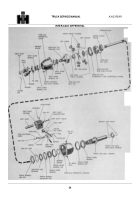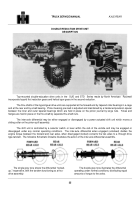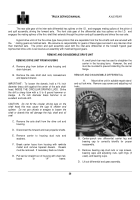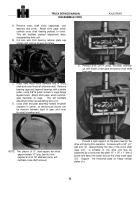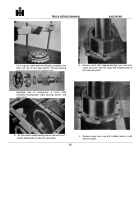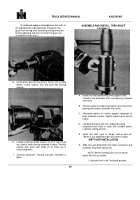TM-5-3805-254-14-P-2 - Page 36 of 894
TRUCK SERVICE MANUAL
AXLE-REAR
CLEAN, INSPECT AND REPAIR
Parts having ground and polished surfaces such as
gears, bearings, shafts and collars, should be cleaned in a
suitable solvent such as kerosene or diesel fuel oil.
GASOLINE SHOULD BE AVOIDED.
Do NOT clean these parts in a hot solution tank or
with water and alkaline solutions such as sodium hydroxide,
orthosilicates or phosphates
We do NOT recommend steam cleaning assembled
drive units after they have been removed from the housing.
When this method of cleaning is used, water is trapped in the
cored passage of the castings and in the close clearances
between parts as well as on the parts. This can lead to
corrosion (rust) of critical parts of the assembly and the
possibility of circulating rust particles in the lubricant.
Premature failure of bearings, gears and other parts can be
caused by this practice. Assembled drive units cannot be
properly cleaned by steam cleaning, dipping or slushing.
Complete drive unit disassembly is a necessary requisite to
thorough cleaning.
ROUGH PARTS
Rough parts such as differential carrier castings, cast
brackets and some brake parts may be cleaned in hot solution
tanks with mild alkali solutions providing these parts are not
ground or polished. The parts should remain in the tank long
enough to be thoroughly cleaned and heated through. This will
aid the evaporation of the rinse water. The parts should be
thoroughly rinsed after cleaning to remove all traces of alkali.
CAUTION:
Exercise care to avoid skin rashes and inhalation
of vapors when using alkali cleaners.
COMPLETE ASSEMBLIES
Completely assembled axles may be steam cleaned
on the outside only, to facilitate initial removal and
disassembly, providing all openings are closed. Breathers,
vented shift units, and all other openings should be tightly
covered or closed to prevent the possibility of water entering
the assembly.
DRYING
Parts should be thoroughly dried immediately after cleaning.
Use soft, clean, lintless absorbent paper towels or wiping rags
free of abrasive material such as lapping compound, metal
filings or contaminated oil. Bearings should never be dried by
spinning with compressed air.
CORROSION PREVENTION
Parts that have been cleaned, dried, inspected and
are be immediately reassembled should be coated with light.
to prevent corrosion. If these parts are to be stored for any
length of time, they should be treated with a good RUST
PREVENTIVE and wrapped in special paper or other material
designed to prevent corrosion.
INSPECT
It is impossible to over stress the importance of
careful and thorough inspection of drive unit parts prior to re-
assembly. Thorough visual inspection for indications of wear or
stress, and the replacement of such parts as are necessary will
eliminate costly and avoidable drive unit failure.
A.
Inspect all bearings, cups and cones, including those
not removed from parts of the drive unit and replace if
rollers or cups are pitted or damaged in any way.
Remove parts needing replacement with a suitable
puller or in a press with sleeves.
Avoid the use of drifts and hammers.
They
may easily mutilate or distort component parts.
B.
first reduction bevel or hypoid and second reduction
spur gears for wear or damage. Gears which are
pitted, galled or worn or broken through case
hardening should be replaced.
When necessary to replace the pinion or
gear of a spiral bevel or hypoid gear set, the entire
gear set should be replaced. We assume no
responsibility for gears of these types when replaced
in any other manner.
C.
Inspect the differential assembly for the following.
1.
Pitted, scored or worn thrust surfaces of
differential case halves, thrust washers, spider
trunnions and differential gears.
Thrust washers must be replaced in sets.
The use of a combination of old and new
washers will result in premature failure.
2.
Wear or damage to the differential pinion and
side gear teeth.
Always replace differential pinions and side
gears in sets.
34
Back to Top

